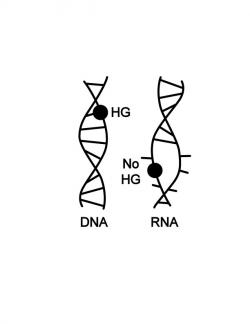Scientists have just uncovered a major difference between DNA and RNA
Time to update the textbooks.
A new study has shown for the first time that RNA - the older molecular cousin of DNA - splits apart when it tries to incorporate change, while DNA can contort itself and change its shape to compensate for any chemical damage.
The research could finally explain why the blueprint of life is made from DNA and not RNA - and it could also prompt a rewrite of the textbooks.
"For something as fundamental as the double helix, it is amazing that we are discovering these basic properties so late in the game," said lead researcher Hashim Al-Hashimi from the Duke University School of Medicine. "We need to continue to zoom in to obtain a deeper understanding regarding these basic molecules of life."
Back in 1953, Watson and Crick first published their model of the DNA double helix, and predicted how the base pairs - A & T and G & C - fit together.
You're probably pretty familiar with that formation by now - two strands of DNA are linked up by the bonding of the base pairs, forming ladder rungs that hold together the twisted ladder of DNA.
But researchers struggled to find evidence that the base pairs were bonding in the way that Watson and Crick had predicted - something they called Watson-Crick base pairs. Then in 1959, biochemist Karst Hoogsteen managed to take a picture of an A–T base pair, showing a slightly more skewed geometry, with one base rotated 180 degrees relative to the other.
Since then, researchers have observed both Watson-Crick and Hoogsteen base pairs in images of DNA.
But five years ago, Al-Hashimi and the Duke team found something that had never seen before: DNA base pairs constantly morphing back and forth between Watson-Crick and the Hoogsteen bonding configurations. This adds a whole other dimension and level of flexibility to DNA's structure.
It turns out that DNA appears to be using Hoogsteen bonding when there's a protein bond to a DNA site - or if there's chemical damage to any of its bases - and once the damage is fixed or the protein is released, the DNA goes back to Watson-Crick bonds.
That discovery was a big deal in itself, but now the team has shown for the first time that RNA doesn't have this ability, which could explain something that scientists have puzzled over for years: why DNA forms the blueprint for life, not RNA.
So, while DNA will absorb chemical damage and adapt to work around it, RNA becomes too stiff and falls apart, making DNA the better structure to pass genetic information down between the generations.
"In DNA this modification is a form of damage, and it can readily be absorbed by flipping the base and forming a Hoogsteen base pair. In contrast, the same modification severely disrupts the double helical structure of RNA," said one of the team, Huiqing Zhou.
"The finding will likely rewrite textbook coverage of the difference between the two purveyors of genetic information, DNA and RNA," said a Duke University press release.
You can see DNA on the left performing Hoogsteen bonding to incorporate damaged base-pairs, while RNA on the right falls apart:
 Huiqing Zhou
Huiqing Zhou
The researchers were able to figure this out by creating double-helices out of RNA and DNA, and using advanced imaging techniques to watch how its base pairs were bonding.
They were able to show that, at any one time, around 1 percent of the DNA bases were changing into Hoogsteen base pairs. But the same thing wasn't seen in the RNA strands.
They tested more of these RNA double-helices under a whole range of conditions, but none of them ever seemed to change to Hoogsteen base pairs. They even forced RNA into forming these Hoogsteen base pairs just to see if it could happen, but as soon as they did, the RNA strands fell apart.
The team explains that this is because the RNA double helical structure is more packed together compared to DNA, and because of that, one RNA base can't change direction without hitting another one or shifting atoms, and ripping the whole structure apart.
"There is an amazing complexity built into these simple beautiful structures, whole new layers or dimensions that we have been blinded to because we didn't have the tools to see them, until now," said Al-Hashimi.
Further research is needed to test the hypothesis that it's this flexibility of DNA, and not RNA, that led to DNA becoming the blueprint of life, but if confirmed, it could help us understand why life on Earth evolved to be the way it is.
And it's pretty cool that after all these years, we're still learning new things about the molecules that make us who we are.
The research has been published in Nature Structural & Molecular Biology.
Comments
Post a Comment